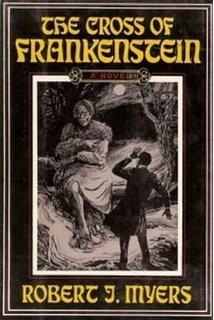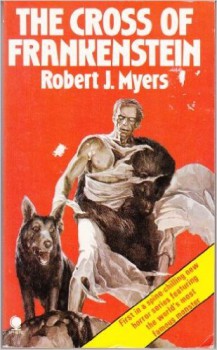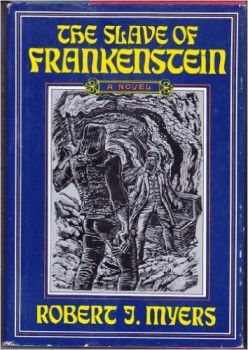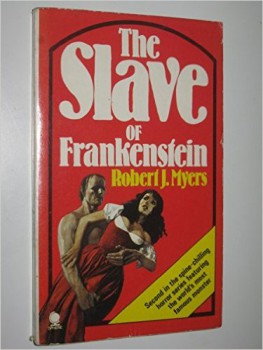R. J. Myers and the Crucifixion of Mary Shelley
NOTE: The following article was first published on May 16, 2010. Thank you to John O’Neill for agreeing to reprint these early articles, so they are archived at Black Gate which has been my home for over 5 years and 250 articles now. Thank you to Deuce Richardson without whom I never would have found my way. Minor editorial changes have been made in some cases to the original text.

 Robert J. Myers is a study in contradictions. A veteran CIA operative, he became the publisher of The New Republic. In the mid-1970s, Myers authored two sequels to Mary Shelley’s classic, Frankenstein or: The Modern Prometheus (1818). Having a longstanding interest in literary pastiches, I tracked down these two long out-of-print titles and read the first, The Cross of Frankenstein (1975). The prolific nature of the Universal and Hammer Frankenstein movies was understandable, but the original novel has always seemed more challenging to extend – even more so than Bram Stoker’s Dracula (1897). Neither story demands literary sequels, nor did their authors choose to pursue them – a fact that makes the ambitions of prospective continuation authors all the more difficult to realize with any degree of success.
Robert J. Myers is a study in contradictions. A veteran CIA operative, he became the publisher of The New Republic. In the mid-1970s, Myers authored two sequels to Mary Shelley’s classic, Frankenstein or: The Modern Prometheus (1818). Having a longstanding interest in literary pastiches, I tracked down these two long out-of-print titles and read the first, The Cross of Frankenstein (1975). The prolific nature of the Universal and Hammer Frankenstein movies was understandable, but the original novel has always seemed more challenging to extend – even more so than Bram Stoker’s Dracula (1897). Neither story demands literary sequels, nor did their authors choose to pursue them – a fact that makes the ambitions of prospective continuation authors all the more difficult to realize with any degree of success.
Mary Shelley’s original reads like a modern fable. The scientist who transgresses nature’s laws is destroyed by the abomination he brought into existence with his own hand. It is the same fable Michael Crichton fashioned nearly 200 years later into Jurassic Park. Shelley’s alternate title for the book, The Modern Prometheus is frequently forgotten, but it is critical to an understanding of how the novel differs from the 1931 Universal horror classic that imbued itself in the public consciousness. The monster of Shelley’s novel may be lacking a flat head and neck bolts, but he makes up for it in spades with his philosophical yearning for his own place in the universe and with the father/creator who abandoned him.
Once the artificial man resolves to destroy his creator, his unrelenting thirst for vengeance leads us to the dire ending where the monster watches his creator expire on his death-bed and resolves to commit suicide thereafter. No matter how many times I’ve read the story, I never doubt the monster’s resolution to end his miserable existence. His purpose has been exhausted. God creates man. Man creates Artificial Man in an attempt to become God. Artificial Man destroys his Creator and then ceases to have a reason to exist. This is more than a re-statement of Michael Crichton at his most didactic; it is also an accurate summation of the theological, moral, philosophical, and bioethical issues the nineteen year-old Mary Shelley wrestled with in her amazing novel.
It is with some sense of discomfort that I found when reading the author’s preface to The Cross of Frankenstein that it was this very conclusion that Myers found so unsatisfying that he felt a sequel was not only possible, but necessary. Myers writes that:
“it seemed out of character for such a monster, however, to have simply finished himself off. There were still worlds to conquer, and his most determined antagonist was dead.”
I was intrigued by this simply because Shelley’s ending seemed so complete. What story did Myers believe still had to be told for the Monster? Knowing the author to be a man of intelligence and learning, my interest was piqued to learn where he would take the story. Sadly, the results make Universal’s 1939 potboiler, Son of Frankenstein seem positively inspired in comparison.
 The Cross of Frankenstein is narrated by young Dr. Victor Saville, the illegitimate son conceived by Victor Frankenstein with an anonymous wench during his final pursuit of the monster near the climax of Shelley’s novel. Right there, I was stopped in my tracks. Had Myers contrived to have Frankenstein father the child earlier in the narrative, it might have been plausible. Shelley goes to great pains to show how both creator and creation sublimate their desires in their all-consuming quest to destroy one another in the story’s third and final act. Additionally, Frankenstein had recently seen his wife and best friend murdered by the monster and yet Myers asks the reader to believe Frankenstein set aside his single-minded obsession that led to his death from physical and mental exhaustion for a quickie with a barmaid. Of course, Myers also later tells us the Monster was out sodomizing animals in the woods so perhaps they both agreed to a break from trying to kill one another for a couple hours to help relieve the tension.
The Cross of Frankenstein is narrated by young Dr. Victor Saville, the illegitimate son conceived by Victor Frankenstein with an anonymous wench during his final pursuit of the monster near the climax of Shelley’s novel. Right there, I was stopped in my tracks. Had Myers contrived to have Frankenstein father the child earlier in the narrative, it might have been plausible. Shelley goes to great pains to show how both creator and creation sublimate their desires in their all-consuming quest to destroy one another in the story’s third and final act. Additionally, Frankenstein had recently seen his wife and best friend murdered by the monster and yet Myers asks the reader to believe Frankenstein set aside his single-minded obsession that led to his death from physical and mental exhaustion for a quickie with a barmaid. Of course, Myers also later tells us the Monster was out sodomizing animals in the woods so perhaps they both agreed to a break from trying to kill one another for a couple hours to help relieve the tension.
Victor Saville grows up ignorant of his heritage. He shares many traits and interests with his infamous father and so the reader is not startled to learn he is, in fact, the latest of the numerous Frankenstein heirs fated to walk in their ancestor’s unhallowed footsteps. The Saville household is made up of Victor’s doting Aunt Margaret, their creepy butler William, and his aunt’s beautiful and innocent ward, Felicia. All appears set for a traditional Frankenstein tale, albeit one that seems to owe more to Frankenstein movies than Shelley’s book. The sinister Mr. Greene shows up unexpectedly just after Young Saville has learned of his parentage. Greene sets the tale in motion by tasking Dr. Saville with finding a fluid that can function as an alternative to blood to complete a mysterious experiment. This is where the story begins to fall apart as Saville is immediately convinced that this strange request must mean that his father’s creation still lives and is behind the mysterious scientific cabal Greene is said to represent. I was left scratching my head at the logic of this conclusion and sadly, not for the last time.
In short order, Victor has sex with Felicia on the front lawn in broad daylight, gets reprimanded by his prim and proper Aunt (so much is made of her hypocritical Bible-thumping opinions that one wonders what sort of lawn games the neighbors observed at the Myers household), snickers through Sunday services with his new girlfriend (even though they should be heartbroken that their actions have led to her being kicked out of the house), and then promptly gets himself shanghaied to America by Greene while seeing Felicia off at the wharf. Victor, gagged and bound in the cargo hold of a ship with Greene’s fierce German Shepherd, Prince, guarding him; fears his sphincter will not hold and he will “beshat” himself. If the reader’s mind isn’t left reeling with that jewel of a phrase, Victor then is convinced for no apparent reason that Greene must have abducted Felicia as well. As before, Victor’s peculiar conclusions are later proven correct. As the narrator, Victor never questions his own logic, so why should the reader carp?
Once in America, who do you suppose turns up as a member of the scientific cabal? Yes, it’s Aunt Margaret’s creepy butler, William. Now at last the plot begins to make sense. William obviously learned of Victor’s parentage and contacted Greene and the others that Frankenstein’s son would be useful to their mysterious experiments. A bit far-fetched maybe, but at least it’s basically sound, right? No such luck. It is a matter of sheer coincidence that William ends up among their rank and the reader never learns how Greene discovered Victor’s identity as a Frankenstein.
 We soon quickly learn that there is no scientific cabal and Greene the flunky is actually the ringleader of this group who were only posing as scientists to dupe Saville. Having lost the dotty old religious fanatic, Aunt Margaret, we quickly meet the dotty old religious fanatic Reverend Ritter (who’s also a comic drunk, for good measure). Ritter is the spiritual leader of what now turns out to be an odd mish-mash of socialist revolutionaries and a religious cult. Greene and William (one of only four members of this supposed army to be given names and dialogue) plot to use the Monster to overthrow America’s fledgling government in the early nineteenth century. Meanwhile, Ritter and his followers believe the Monster’s promise of a Resurrection Day in which their Savior (once Victor generates more blood-substitute fluid) will be able to restore their departed loved ones to life.
We soon quickly learn that there is no scientific cabal and Greene the flunky is actually the ringleader of this group who were only posing as scientists to dupe Saville. Having lost the dotty old religious fanatic, Aunt Margaret, we quickly meet the dotty old religious fanatic Reverend Ritter (who’s also a comic drunk, for good measure). Ritter is the spiritual leader of what now turns out to be an odd mish-mash of socialist revolutionaries and a religious cult. Greene and William (one of only four members of this supposed army to be given names and dialogue) plot to use the Monster to overthrow America’s fledgling government in the early nineteenth century. Meanwhile, Ritter and his followers believe the Monster’s promise of a Resurrection Day in which their Savior (once Victor generates more blood-substitute fluid) will be able to restore their departed loved ones to life.
Myers has an inspired bit here where the corpses of the congregation’s deceased family members are used as raw materials for further Frankenstein experiments in reanimating bodies that have been stitched together patchwork-style. This has the potential for genuine ghoulish chills when one imagines what the Resurrection Day will look like to the congregation. Sadly, Myers squanders this opportunity as well by only having Victor discover the truth. After building up Ritter as a major supporting player, Myers has him turn up crucified by either Greene (his political rival) or the Monster – the author never explains which one is guilty of the murder.
There’s also a nice juicy role for Jenny, Greene’s attractive young wife (never mind the fact that they’ve been married for many years and yet she is still described as young while her husband is now middle-aged). Jenny is the congregation’s nurse. She grew up in poverty and graduated from barmaid to wife to nurse and yet is Victor’s equal in understanding the scientific genius of his father’s notebooks. Of course, Jenny knows a good thing when she sees it and wanting a better biological father for her child, she jumps Victor’s bones as fast as you can say “Nineteenth century morals, my ass!” Victor is quite the lucky guy in that a preacher’s daughter like Felicia and the wife of a jealous and abusive husband like Greene require no seduction whatsoever from our hero. These women are willing and eager and Myers, it must be said, exercises surprising restraint in detailing their couplings. Of course, that’s because he’s saving it up for the Big Bang later on in the narrative.
Victor considers his infidelity to Felicia and in the span of a single paragraph rationalizes that the love of his life would understand the casual sex with Jenny that he believes has produced his own illegitimate heir meant nothing and so concludes there is no reason to even tell her. What happens to Frankenstein stays in Frankenstein, apparently (or words to that effect). However, Jenny’s scheming of parental selection is all for naught since she ends up murdered the next morning — how convenient for Victor, casual sex with no strings attached. Of course, a short time later Victor witnesses the congregation follow Reverend Ritter’s drunken homily with an all-out Rite of Spring orgy with Benediction of the most base nature imaginable granted by the monster’s monstrous member which Myers describes with such awe and in such loving detail that it reads as risible as Richard Jaccoma’s dreadful soft porn Fu Manchu spoof, Yellow Peril (1978). Who is the Monster’s mate for the orgy? You guessed it – Felicia herself.
Naturally, the reader expects a sexually-liberated-before-his-time character like Victor not to harbor any petty jealousy, right? It’s not like he hasn’t enjoyed his own on the side, too. Nope, deep down Victor is as much a traditional nineteenth century guy as the next. For the entire remainder of the book, he is tortured by Felicia’s callous betrayal and the image of her ecstasy while mounting the Monster stays in his mind and the reader’s (although evoking a considerably different reaction than the author evidently intended). Shortly before this book was published, Mel Brooks and Gene Wilder wrung puerile anatomical humor about the Monster’s privates in Young Frankenstein (1974), but Myers takes it to a level that approaches Kurt Vonnegut without the knowing satire to salvage it’s dignity. Witness his description of the climactic thunderstorm:
“the autumn rain released every fluid ounce, like a primitive orgasm.”
There’s also plenty more lapses in logic along the way, too as Victor poisons Prince’s dinner and then has the German Shepherd turn up later in the story inexplicably alive (no suggestion of any Frankenstein resurrection for the pooch, either). Felicia gets what’s coming to her though and ends up with Greene bashing her skull in with a rock on the final pages of the book. See, boys and girls, the lesson is guys are allowed to cheat, but sluts always get killed – Ian Fleming was right. The 1970s seemed to bring the porn out in pulp fiction in a misguided and juvenile attempt to achieve literary sophistication with the genre. Once the reader gets past the shock value, you’re left with the fact that authors like R. J. Myers end up looking pathetic as if the world just caught them playing with themselves. The Monster is almost an oversight in the story since what Myers does to poor Mary Shelley’s classic is the real horror story.
William Patrick Maynard was licensed by the Sax Rohmer Literary Estate to continue the Fu Manchu thrillers beginning with The Terror of Fu Manchu (2009; Black Coat Press) and The Destiny of Fu Manchu (2012; Black Coat Press). The Triumph of Fu Manchu is coming soon from Black Coat Press.
Wonderful reviews and great insight, Bill. I had been warned off these many years ago by someone who opinion I highly regard. I have since read to novels I enjoyed, both inspired by and authorized by Universal films:
FRANKENSTEIN: THE SHADOW OF FRANKENSTEIN, by Stefan Petrucha. This is what the author imagines James Whale might have done, had he made a third film, following The Bridge of Frankenstein. It’s set in England, in Whitechapel, during Jack the Ripper’s reign of terror. It was interesting and fun to read.
The other is: THE BRIDE OF FRANKENSTEIN: PANDORA’S BRIDE, by Elizabeth Hand. It’s set in Germany at the height of the Weimer Republic, and features a most interesting cast of characters from the period in real and film history.
These were published by Dark Horse books in 2006 and 2007. There have been sequels THE MUMMY, THE WOLFMAN, DRACULA, and a really excellent science-fiction sequel to THE CREATURE OF THE BLACK LAGOON, each written by a different author. These are not literary sequels, but sequels to the classic Universal films. As far as I know, no other sequels of this sort were ever published. Although the sequel to the Wolfman is the weakest, I recommend it and the others, if for no other reason than to view these as films recently discovered in the vaults of Universal Studios.
Thanks for the recommendations, Joe. I remember the Dark Horse series, but hadn’t read any of them at the time.